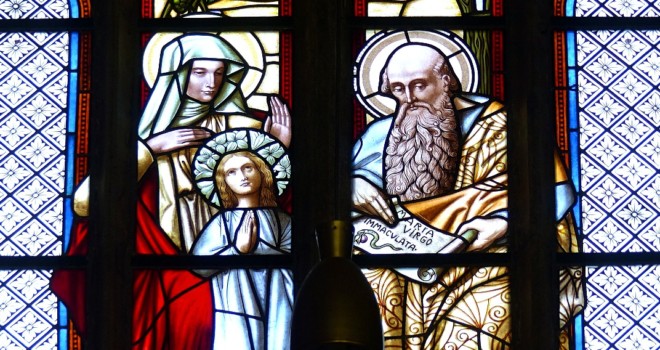Although they are known for being the parents of Mary and the grandparents of Jesus, Sts. Joachim and Anne spent the vast majority of their lives as a couple facing infertility. Pious tradition tells us that they were quite old when Mary was conceived, and then they entrusted her to the care of the Temple when she was weaned. They spent most of their life together as a childless couple. Yet, their love was immensely fertile.
The Story Behind the Icon
Although they are never mentioned in the Scriptures, pious
tradition has handed down the identities of these crucial figures in salvation
history. There are several popular icons that feature Joachim and Anne. The
first is one a picture of the elderly couple embracing a toddler Mary. Another
features St. Anne giving birth to Mary. Yet another common icon shows St.
Joachim and Anne presenting Mary in the Temple as a small child.
But my favorite icon of this couple is one of them
embracing.
As the story goes, Joachim and Anne were a pious couple who
had been hoping and praying for a child all of their marriage. Though
criticized by their neighbors, they placed their trust in God. They knew that
he would give them a child if he willed it, and in the meantime, they focused
on growing in holiness as a couple.
Finally, St. Joachim decided to go into the wilderness to
pray for a time, and St. Anne stayed behind, doing the same. As someone who has
faced secondary infertility twice, this detail alone amazes me. This story
happened long before NFP and charting for fertility were invented, but every
infertile couple feels a pull to “try” to get pregnant, and I’d imagine that
Anne and Joachim were no exception. To spend time physically apart means that
there will be no possibility of pregnancy occurring, and that cycle apart always
leaves the couple wondering, “What if that would have been THE cycle when we
would have conceived?” To give that time to God shows beautiful, heroic trust
on the part of Anne and Joachim.
While they were apart, St. Gabriel visited each of them, and
told them that they would conceive a daughter. This detail, too, is significant.
In stories of infertile couples in Scripture, either God does not send an angel
to either parent (such as in the story of Hannah), or he only sends the angel
to one (Elizabeth and Zachariah). The only exception to this rule is Mary and
Joseph, but even in this case, Joseph receives a message from the angel after
Mary does. Also, at least one spouse is usually doubtful in these cases.
Zachariah doubts and loses the power of speech (even though he was the one to
see the angel), while Elizabeth believes that God will give them a child.
Abraham believes, but Sarah laughs.

But in the case of Anne and Joachim, God not only sent the
angel Gabriel to both of them but he also did it simultaneously. And both
spouses responded with joy and faith. Joachim raced home to Anne, and Anne met
and embraced him at the city gate. This moment is what is depicted in the icon.
However, the icon represents another, more intimate moment.
That depiction of their loving embrace is actually meant to symbolize the intimate,
marital embrace by which Mary was conceived. The beauty of the Immaculate
Conception is that it occurred by means of an ordinary conjugal act, made holy
by God’s grace at work in that marriage.
And, of course, since this was prior to NFP and charting
fertile signs, Anne and Joachim really had no reason – other than faith – to
believe that this embrace would result in a child. They came together only
because of the message of the angel.
This faith of theirs, lived out in the context of ordinary
marital love, is what is really remarkable about them. God didn’t choose just
any couple to be the parents of Mary. He chose a couple who was already living
out a devout life together, trusting in God’s plan. He knew that Mary would
need an example of that heroic, faithful trust in her life.
Looking for Fertility in Infertility
After decades of hoping, praying, and trying, Anne and
Joachim were finally granted a child. But for many couples facing infertility,
a biological child will never be possible. What about them? Is their faith less
because they aren’t able to conceive?
This is where it helps to reflect on the true fruitfulness
of Anne and Joachim. If they had never conceived a child, they would have
likely still had tremendous faith in God’s plan for their lives. Their prayers
and their holiness weren’t contingent on receiving an answer to that prayer.
But what is also so fruitful about their love is the witness
it leaves behind. They weren’t happy about their infertility. It was a real,
true sorrow for them. Joachim’s trip into the wilderness was a culmination of
decades of heartache. Even the sorrow of an infertile couple can be a powerful
witness. It is easy to praise God when everything is going well, but it can be
near impossible when facing prolonged suffering. People were amazed by the
faith of Anne and Joachim, which persisted in suffering. One of my best friends
has been facing infertility for years, but her and her husband’s faith in the
midst of so much suffering has been a powerful witness to me, reminding me to
trust God even when it is painful.
This kind of fruitfulness doesn’t take away the pain of
infertility, but it can have a powerful impact on the Church. My friend and her
husband (both of whom do a lot of work within the diocese, ministering to other
married couples) have scores of spiritual children who have been impacted by
their witness. This past year, she even gave a presentation to seminarians,
telling them about her journey with infertility. The seminarians that I knew
were deeply moved by her witness, the effect of which will likely ripple down
throughout their decades of priestly ministry.
Joy in Suffering
Many modern preachers spread the message of the “prosperity Gospel” (i.e. if you have faith in God, then he will give you whatever you want and make you rich). Even those who don’t preach that message advocate for acting happy in suffering, often avoiding showing sorrow of any kind.
But when Jesus was on the cross, he wasn’t singing and
laughing. He said, “My God, my God, why have you forsaken me?” As one who was fully
human and divine, Jesus knew that the Father had not forsaken him. But
he said this for our sake, to show us we can cry out in our suffering.
So where is the joy? The joy is in the persistent trust. Joy doesn’t mean cheerful happiness. It means deep, abiding peace, that enables one to persist in faith. This was the joy of Anne and Joachim, and it is the joy that they want for all the couples they intercede for — especially those suffering from infertility.
✠
image: Wolfgang Sauber [CC BY-SA 4.0], via Wikimedia Commons














